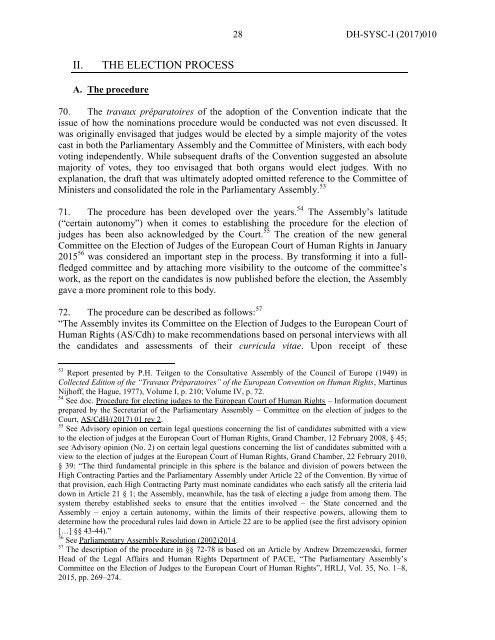Working document in view of the 3 DH-SYSC-I meeting
DH-SYSC-I(2017)010__EN
DH-SYSC-I(2017)010__EN
You also want an ePaper? Increase the reach of your titles
YUMPU automatically turns print PDFs into web optimized ePapers that Google loves.
28 <strong>DH</strong>-<strong>SYSC</strong>-I (2017)010<br />
II.<br />
THE ELECTION PROCESS<br />
A. The procedure<br />
70. The travaux préparatoires <strong>of</strong> <strong>the</strong> adoption <strong>of</strong> <strong>the</strong> Convention <strong>in</strong>dicate that <strong>the</strong><br />
issue <strong>of</strong> how <strong>the</strong> nom<strong>in</strong>ations procedure would be conducted was not even discussed. It<br />
was orig<strong>in</strong>ally envisaged that judges would be elected by a simple majority <strong>of</strong> <strong>the</strong> votes<br />
cast <strong>in</strong> both <strong>the</strong> Parliamentary Assembly and <strong>the</strong> Committee <strong>of</strong> M<strong>in</strong>isters, with each body<br />
vot<strong>in</strong>g <strong>in</strong>dependently. While subsequent drafts <strong>of</strong> <strong>the</strong> Convention suggested an absolute<br />
majority <strong>of</strong> votes, <strong>the</strong>y too envisaged that both organs would elect judges. With no<br />
explanation, <strong>the</strong> draft that was ultimately adopted omitted reference to <strong>the</strong> Committee <strong>of</strong><br />
M<strong>in</strong>isters and consolidated <strong>the</strong> role <strong>in</strong> <strong>the</strong> Parliamentary Assembly. 53<br />
71. The procedure has been developed over <strong>the</strong> years. 54 The Assembly’s latitude<br />
(“certa<strong>in</strong> autonomy”) when it comes to establish<strong>in</strong>g <strong>the</strong> procedure for <strong>the</strong> election <strong>of</strong><br />
judges has been also acknowledged by <strong>the</strong> Court. 55 The creation <strong>of</strong> <strong>the</strong> new general<br />
Committee on <strong>the</strong> Election <strong>of</strong> Judges <strong>of</strong> <strong>the</strong> European Court <strong>of</strong> Human Rights <strong>in</strong> January<br />
2015 56 was considered an important step <strong>in</strong> <strong>the</strong> process. By transform<strong>in</strong>g it <strong>in</strong>to a fullfledged<br />
committee and by attach<strong>in</strong>g more visibility to <strong>the</strong> outcome <strong>of</strong> <strong>the</strong> committee’s<br />
work, as <strong>the</strong> report on <strong>the</strong> candidates is now published before <strong>the</strong> election, <strong>the</strong> Assembly<br />
gave a more prom<strong>in</strong>ent role to this body.<br />
72. The procedure can be described as follows: 57<br />
“The Assembly <strong>in</strong>vites its Committee on <strong>the</strong> Election <strong>of</strong> Judges to <strong>the</strong> European Court <strong>of</strong><br />
Human Rights (AS/Cdh) to make recommendations based on personal <strong>in</strong>ter<strong>view</strong>s with all<br />
<strong>the</strong> candidates and assessments <strong>of</strong> <strong>the</strong>ir curricula vitae. Upon receipt <strong>of</strong> <strong>the</strong>se<br />
53 Report presented by P.H. Teitgen to <strong>the</strong> Consultative Assembly <strong>of</strong> <strong>the</strong> Council <strong>of</strong> Europe (1949) <strong>in</strong><br />
Collected Edition <strong>of</strong> <strong>the</strong> “Travaux Préparatoires” <strong>of</strong> <strong>the</strong> European Convention on Human Rights, Mart<strong>in</strong>us<br />
Nijh<strong>of</strong>f, <strong>the</strong> Hague, 1977), Volume I, p. 210; Volume IV, p. 72.<br />
54 See doc. Procedure for elect<strong>in</strong>g judges to <strong>the</strong> European Court <strong>of</strong> Human Rights – Information <strong>document</strong><br />
prepared by <strong>the</strong> Secretariat <strong>of</strong> <strong>the</strong> Parliamentary Assembly – Committee on <strong>the</strong> election <strong>of</strong> judges to <strong>the</strong><br />
Court, AS/CdH/(2017) 01 rev 2.<br />
55 See Advisory op<strong>in</strong>ion on certa<strong>in</strong> legal questions concern<strong>in</strong>g <strong>the</strong> list <strong>of</strong> candidates submitted with a <strong>view</strong><br />
to <strong>the</strong> election <strong>of</strong> judges at <strong>the</strong> European Court <strong>of</strong> Human Rights, Grand Chamber, 12 February 2008, § 45;<br />
see Advisory op<strong>in</strong>ion (No. 2) on certa<strong>in</strong> legal questions concern<strong>in</strong>g <strong>the</strong> list <strong>of</strong> candidates submitted with a<br />
<strong>view</strong> to <strong>the</strong> election <strong>of</strong> judges at <strong>the</strong> European Court <strong>of</strong> Human Rights, Grand Chamber, 22 February 2010,<br />
§ 39: “The third fundamental pr<strong>in</strong>ciple <strong>in</strong> this sphere is <strong>the</strong> balance and division <strong>of</strong> powers between <strong>the</strong><br />
High Contract<strong>in</strong>g Parties and <strong>the</strong> Parliamentary Assembly under Article 22 <strong>of</strong> <strong>the</strong> Convention. By virtue <strong>of</strong><br />
that provision, each High Contract<strong>in</strong>g Party must nom<strong>in</strong>ate candidates who each satisfy all <strong>the</strong> criteria laid<br />
down <strong>in</strong> Article 21 § 1; <strong>the</strong> Assembly, meanwhile, has <strong>the</strong> task <strong>of</strong> elect<strong>in</strong>g a judge from among <strong>the</strong>m. The<br />
system <strong>the</strong>reby established seeks to ensure that <strong>the</strong> entities <strong>in</strong>volved – <strong>the</strong> State concerned and <strong>the</strong><br />
Assembly – enjoy a certa<strong>in</strong> autonomy, with<strong>in</strong> <strong>the</strong> limits <strong>of</strong> <strong>the</strong>ir respective powers, allow<strong>in</strong>g <strong>the</strong>m to<br />
determ<strong>in</strong>e how <strong>the</strong> procedural rules laid down <strong>in</strong> Article 22 are to be applied (see <strong>the</strong> first advisory op<strong>in</strong>ion<br />
[…] §§ 43-44).”<br />
56 See Parliamentary Assembly Resolution (2002)2014.<br />
57 The description <strong>of</strong> <strong>the</strong> procedure <strong>in</strong> §§ 72-78 is based on an Article by Andrew Drzemczewski, former<br />
Head <strong>of</strong> <strong>the</strong> Legal Affairs and Human Rights Department <strong>of</strong> PACE, “The Parliamentary Assembly’s<br />
Committee on <strong>the</strong> Election <strong>of</strong> Judges to <strong>the</strong> European Court <strong>of</strong> Human Rights”, HRLJ, Vol. 35, No. 1–8,<br />
2015, pp. 269–274.



